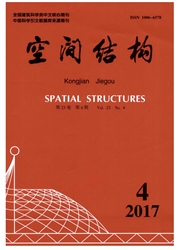

 中文摘要:
中文摘要:
输电铁塔的塔身由主材、斜材、辅材组合而成,主材和斜材主要承受轴向力,辅材的作用是控制主材和斜材受压时的失稳模式,以便提高主材和斜材的抗失稳力.目前已有辅材尚未失稳但主材(或斜材)已经失稳的研究工作.利用能量法,本文研究了不但主材(或斜材)失稳而且辅材也已经失稳的失稳模式,研究辅材和主材(或斜材)的失稳模式与其弯曲初始变形的关系,给出了临界力表达式,给出主材(或斜材)失稳模式间的转换临界值,该临界值得到了本文给出的试验结果验证.研究成果可用于指导辅材的尺寸设计、提高主材(或斜材)的抗失稳能力.
 英文摘要:
英文摘要:
The lattice steel towers of electric power transmission consists of legs, diagonal bracings, and auxiliary members. Legs and diagonal bracings mainly bear axial forces. The roles of the auxiliary mem- bers are to control the buckling models of legs and diagonal bracings and to increase the anti-buckling capacity of legs and diagonal bracings in support structures. The buckling models of legs (or diagonal bracings) have been studied by some researchers when the auxiliary members do not lose balance. Herein, by the energy method, the buckling of both legs (or diagonal bracings) and auxiliary members are discussed. The relations of legs (or diagonal bracings) buckling models and their initial bending displacement are analyzed. The critical force expression is given and the threshold value of the initial clisplacement is given and checked through buckling experiments of support structures. The results of this paper can be used to increase the anti-buckling capacity of legs and diagonal bracings in support structures.
 同期刊论文项目
同期刊论文项目
 同项目期刊论文
同项目期刊论文
 Determination of all elastic and plastic parameters for sheets of cubic metals only by uniaxial tens
Determination of all elastic and plastic parameters for sheets of cubic metals only by uniaxial tens 期刊信息
期刊信息
